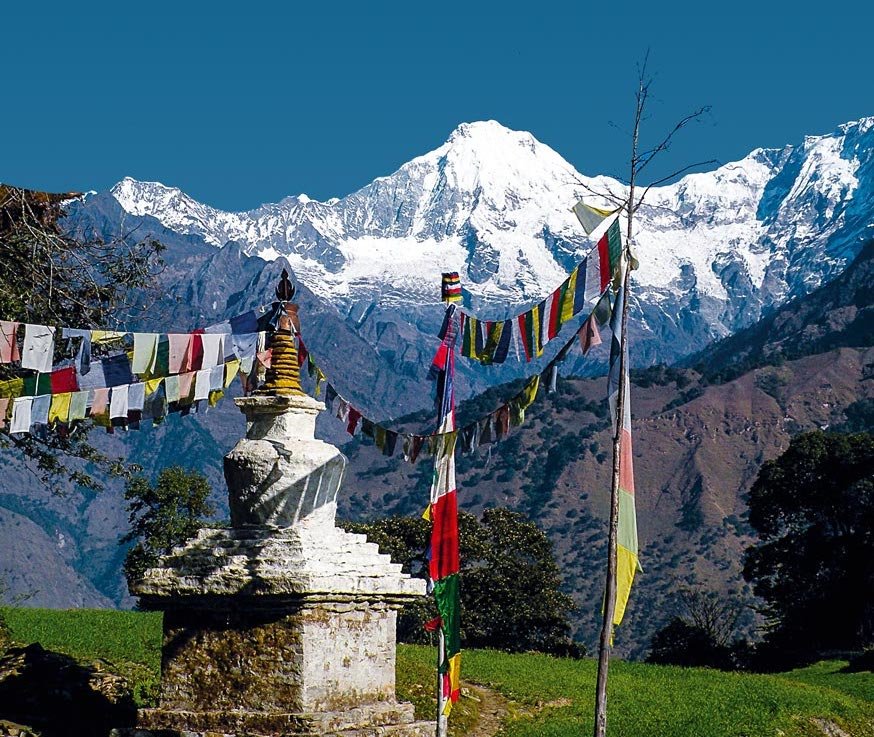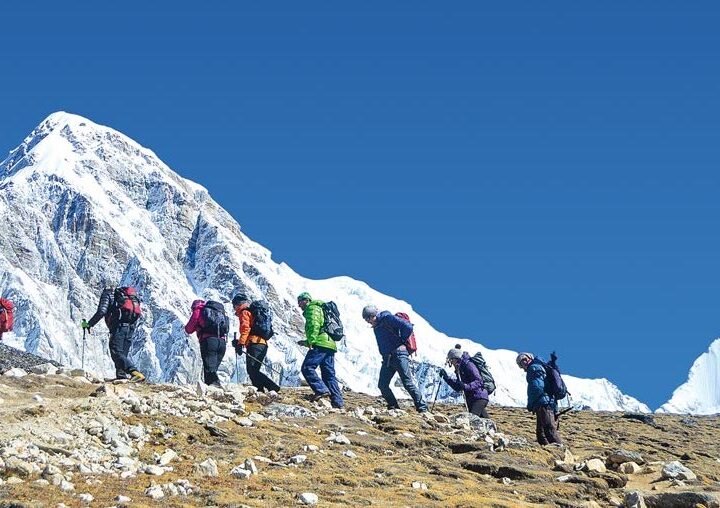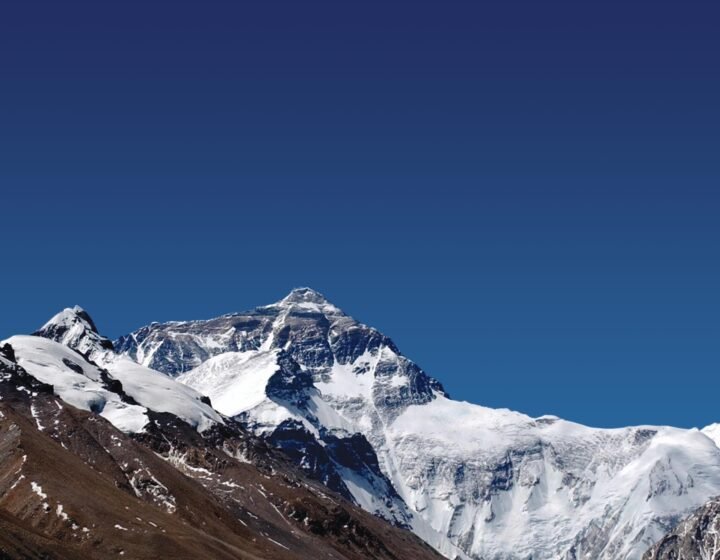- Details
Detailed itinerary
Itinerary- Useful Info
- Trip Map
- FAQ

Trip overview
The Tibetan term “Tsombo,” which means “colorful,” was originally the source of the valley’s name. The Tsum valley is located in northern Gorkha, to the east of Manaslu, and close to the Tibetan border. The valley is a treasure trove of historical art, culture, and religion set against the spectacular Ganesh Himal, Sringi Himal, and Boudha peaks. The Tsum valley, which derives from the east and southern glaciers of Sringi Himal and the east and southern glaciers of Ganesh Himal, is drained by the Shear Khola.
The Tsum valley is also referred to as a Beyul, one of the secret valleys where Padmasambhava blessed as havens to be found during the time when the world was heading towards disaster. Buddhism has a vast history, which can be seen in Tsun Valley. Milarepa, a Buddhist saint, is said to have meditated in a cave in these mountains. This area is thought to have a favorable atmosphere for fortunate events. Tsum residents have a deep faith in Buddhism.
They make offerings to Buddha, Guru Rinpoche (Padmasambhava), and several bodhisattvas. They erect prayer flags, light butter lamps, and Khata or Mani walls in monasteries, and have a deep belief in Lamas’ rebirth. The thirteen provinces governing the Tsum valley’s current territorial division are known as “Tsum Tso Chuksum.” Many of the remnants of the Tsum Kingdom can still be found in the secluded valley, which has largely escaped from infrastructure and urbanization. As a result, the valley’s native culture is still there and unaltered.
Highlights
- The Horse Festival
- “Happy Saka Dawa,” a Unique festival.
- Sacred place T elevation of 4800m I,e, Ganesh Himal
- Mu Gumba, Mileripa cave, and Rachen Gumba
- Rare Flora and fauna
Itinerary
Day 1: Arrive in Kathmandu / Airport transportation/hotel accommodation.When you arrive in Kathmandu, the Tsum Valley Trek begins. Our representatives will meet you at Tribhuvan International Airport and transport you to your hotel. Enjoy a drink at the hotel. We'll serve you a delicious welcome dinner in the evening. In the meantime, take a stroll through Thamel Town. In Kathmandu, spend the night.
The day starts with a hearty breakfast. Your trek guide will thoroughly brief you on the trek. He will go to the appropriate trek offices to get the necessary permits. Meanwhile, you'll take a scenic, cultural tour of Kathmandu City, visiting some of the city's most popular historical and cultural sites.
Some of the most popular UNESCO World Heritage sites are visited by an experienced tour guide, including Swayambhunath, Pashupatinath, Kathmandu Durbar Square, and Boudhanath. The well-guided tour provides information about the UNESCO sites. You can learn about Kathmandu's heritage and the history of Hinduism and Buddhism. In Kathmandu, spend the night.
You will depart Kathmandu for your trek's starting point. After a delicious breakfast, you'll board a private jeep and begin your journey along the scenic Prithvi Highway. The road journey follows the massive Trishuli River before detouring north to Gorkha District.
The historic Gorkha district follows the Budi Gandaki River to the bustling Arughat Bazaar. Arughat Bazaar in Gorkha District is located 126 kilometers west of Kathmandu. After a 7-8-hour journey, you'll arrive in Arughat, where you'll spend the evening observing the locals' lifestyle and ambiance. Spend the night in Arughat.
Arughat Bazaar serves a delicious breakfast. After breakfast, you'll depart Arughat and begin ascending the Budi Gandaki River. The trail ascends through dense forest and small multi-ethnic settlements. Continue climbing alongside the Budi Gandaki hydropower plant after crossing a suspension bridge over the Budi Gandaki. To reach Soti Khola, the trail passes through beautiful rice and millet fields at Shanti Bazaar and crosses Arkhet Khola. To get to Soti Khola, you have to walk past beautiful waterfalls in Kuerepani. Spend the night in Soti Khola.
After leaving Soti Khola, you'll start climbing upstream to reach the tranquil Machha Khola. The 177-meter upstream climb takes you through the beautiful Sal forests. The trail climbs along the Budi Gandaki River for another 4-5 hours. After passing through the Sal forest, you'll climb through rocky ridges towards the Gurung village of Lapubesi. After a delicious lunch, continue trekking along the Budi Gandaki River to Machha Khola. Spend the night in Machha Khola.
After leaving Machha Khola, continue your journey along the Budi Gandaki River. The trail is flanked on one side by lush Sal forests and on the other by a massive river that flows north towards Thado Khola. Cross the Thado Khola to get to Khorlabesi. The trail leads to Tatopani through lush coffee, buckwheat, and tobacco fields. As you leave the forest, you'll enter a narrow gorge that leads directly to Tatopani. Before continuing on your trek to Dobhan village, stop for a delicious lunch. Spend the night in Dobhan.
Leaving Dobhan village, you'll start climbing uphill along the Dobhan River, eventually reaching the confluence with the Budhi Gandaki River to the east. Thulo Dhunga is reached after a short hike. Continue trekking towards Thado Bharyang after crossing an old suspension bridge over the Yaru River. The path gently ascends towards the village of Jagat, where you can stop for lunch. After leaving Jagat, you will begin your trek towards Philim via Sirdibas village. Spend the night in Philim.
After leaving Philim village, start climbing above the Budi Gandaki Valley towards Chumling village. The path ascends the narrow ridge and continues to Chisopani village. You'll enter the picturesque Lower Tsum Valley and begin climbing uphill along the Siyar River's south side. Continue trekking through the vibrant grain, potato, and bean fields that overlook the stunning Shringi Himal. The trail descends briefly to Gumlung village before continuing upstream along the Siyar River towards Chumling.
After leaving Chumling, start climbing upstream along the Siyar Khola. Take in the breathtaking view of the Ganesh Himal Range along the exposed ridge. The trail continues on towards Ripchet village, passing traditional Tibetan-style settlements. Continue on the trail to Rainjam village after a delicious lunch. Climb upstream along the Serpu Khola until you reach the village of Chhokangparo. Spend the night in Chhokangparo.
After leaving Chhokangparo, start climbing through the rocky terrain towards Lama Gaon. Milarepa Piren Cave is reached after a short uphill trek. Piren Phu, which translates to Pigeons' Cave, is the name given to Milarepa Cave in Tsum Valley. The caves are said to be where the revered saint Milarepa meditated. You can go to the nearby gompas of Tara and Milarepa. After leaving the caves, begin climbing upstream along Shiyar Khola and continue past Pangdun (3258m) to Chule village.
After leaving Chule village, you'll begin your journey north, close to the Tibetan border. You'll walk along the west bank of the Tsum valley, past Nile village, until you reach Mu Gompa. Witness the beautiful Tibetan landscape that surrounds Mu Gompa. After a few hours of climbing through rock moraines, you will arrive at Mu Gompa, which is nestled on the glacier. In addition, the trek's highest point, Mu Gompa, is located near the Tibetan border in the north. Spend the night in Mu Gompa.
Wake up to a stunning view of the Mu Gompas. After a delicious local breakfast, you'll go on a tour of the Mu Gompa valley. Begin your exploration of the rocky moraines and glaciers that surround Mu Gompa. After leaving the gompas, you'll start climbing Pika Himal, a local landmark. The local peak is 4,865 meters high and is only a few kilometers away from Mu Gompa. The natural sights of Mu Gompa, Shiar Khola, and scenic mountains can be seen from the top. Spend the night in Mu Gompa.
After leaving Mu Gompa, start climbing downhill along the Siyar River towards Lamabagar. When you arrive, you may find yourself in front of Rachen Gompa. Rachen Gompa is the region's only nunnery. The local nun may offer local delicacies and Tibetan tea to visitors who visit the beautiful site. After leaving Rachen Gompa, you'll begin exploring Milarepa's many caves on your way to Gonhgye Gompa.
Rachen Monastery serves a delicious local breakfast. You'll start climbing downhill along the Shiar River towards Lamagaon from here. The difficult trail returns you to Chhekampar village. To get to Dumje village, walk past a small monastery and across a wooden bridge. Dumje is a small village with no more than eight houses. After lunch, consider visiting the nearby Lungdang gompa.
After leaving Dumje village, you'll retrace your steps and continue trekking downhill. The scenic trail along Shiar Khola leads to Lokpa village. The path continues through a lush forested path, following the Samba Falls to Philim village. The entire journey could take anywhere between 6-7 hours. The easy hike brings you closer to the Budi Gandaki River. Spend the night in Philim
Today is a simple trek day. After breakfast, you'll retrace your steps along the Dobhan River to Tatopani village. The picturesque trail continues downstream along the Dobhan River, past Jagat village, to Tatopani. After arriving early, consider taking a dip in Tatopani's natural hot spring. Both locals and foreigners may be seen swimming in the water.
After leaving Tatopani, you'll start retracing your steps back to Soti Khola. The trail passes through Sirdibas village, which is known for its large, decorated terraced fields. Continue walking through the dense settlement until you reach Khorlabesi village, where you can take a downhill trail along the Budi Gandaki River.
Khorlabesi is a good place to eat lunch. After finishing, you'll leave the forested village and continue downhill through Tharo Khola to Macha Khola. The final section of the trek follows the Budi Gandaki River towards Lapubesi village, passing two large waterfalls on the way to Soti Khola. Spend the night in Soti Khola.
You'll leave Soti Khola behind and begin the final leg of your journey. The trail descends along the Khola, passing through lush villages on its way to Kyoropani. The trail follows the Kali Gandaki River downstream to Arughat Bazaar. The entire journey could take several hours. After arriving, you can have lunch and spend the evening exploring the lovely town. Spend the night in Arughat.
After leaving Arughat Bazaar, you'll start driving back to Kathmandu. After a delicious breakfast, you board a private jeep. As you begin driving downhill along the Budi Gandaki River, bid farewell to the beautiful Gorkha District. After exiting, continue driving along the Trishuli River on the Prithvi Highway. The entire road trip could take 7-8 hours. When you arrive, you have the option of relaxing in your hotel or exploring the beautiful city. In Kathmandu, spend the night.
The day starts with a hearty breakfast. Today is a day of rest in Kathmandu. You can take a cultural tour of the neighboring cities of Lalitpur and Bhaktapur. If you need to unwind, you can go to the local massage parlor in Thamel. In Kathmandu, spend the night.
Today is the last day of the Tsum Valley Trekking trip. As you begin your journey to the airport, bid farewell to Kathmandu. We'll pick you up two hours before your flight.
Useful Info
- When booking and arriving, all foreign visitors must provide their personal information, including passport and visa information.
- All trekkers are expected to bring non-biodegradable items, and the use of intoxicating substances and alcohol while trekking is strictly forbidden. It is also advised to keep a day set aside to deal with unforeseen events.
- It is a must for all travelers to maintain their passports or visa with travel agencies.
- There is a larger risk of becoming dehydrated, so drink plenty of water regularly and carry additional bottles with you.
- When hiking at a higher altitude, layering your clothing is the greatest approach to regulating your body temperature. Therefore, zippered clothing is the ideal choice.
- Because mobile phone and camera batteries have a high likelihood of going dead or losing power quickly, a portable charger is essential for your electronic devices.
Trip Map

FAQs
-
Do I need travel insurance for the Manaslu Trek and Tsum Valley?
Yes, travel insurance is a need for the Manaslu Trek and Tsum Valley. Bring genuine travel insurance that can protect you against all potential hazards, including the need for a mountain rescue evacuation and medical costs.
-
Is it required to tip the porter and guide?
Actually, it isn't, however it is expected that you'll give something more. Therefore, we advise you to at least make a small preparation for your guide and porter. But that doesn't imply you should only donate a little. They are yours to give as you like. Throughout your journey, your guide and porter will be of great assistance to you.
-
What is the Price of Tsum Valley Trekking Permits?
Tsum Valley trekking needed only two permits. Tsum Valley Restricted Area Permit (RAP) and Manaslu Conservation Area Project are the two (MCAP). Remember that at least two trekkers are required to obtain the RAP from the Department of Nepal Immigration. Tsum Valley trekking permits can only be obtained through certified Nepalese trekking firms. The cost of an MCAP permit is the same throughout the year, however, the limited area permits vary depending on the season and, of course, the number of trek days. During the months of September to November, the Tsum Valley Restricted Area Permit (RAP) costs USD 40 for the first week. If you spend longer than a week, each additional day costs USD 7. From December through August, the RAP charge will be reduced to USD 30 for the first week. A further extension or extra permission costs USD 7 per day. The second permit required for trekking in Tsum Valley is the Manaslu Conservation Area Permit (MCAP), which costs approximately USD 30 (NPR 3000) for foreigners and USD 10 (NPR 1000) for SAARC.
-
What is the highest elevation on the Tsum Valley Trek?
Tsum valley trek's highest point is 3700 meters/12139.11 feet.








